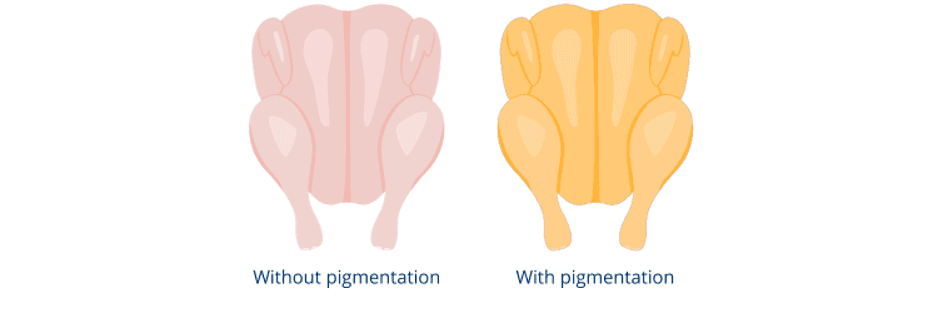


Pigmentation of Broiler Skin: Enhancing Color in Your Broiler Meat
Aug 28, 2025
In many countries, the demand for broiler meat boasting a rich yellow-to-orange pigmentation is on the rise. This appealing hue not only makes the meat more visually enticing but also indicates the presence of important nutrients. Traditionally, this pigmentation was achieved through carotenoids, natural pigments found in feedstuffs, such as yellow maize or alfalfa meal. However, ensuring a year-round supply of these ingredients can be challenging. In this blog, we explore the fascinating world of broiler skin pigmentation, the role of carotenoids, and guidelines for achieving the desired results.

Carotenoids as Feed Additives
Carotenoids are naturally occurring yellow, orange, and red pigments found in plants. To meet the market's demand for pigmented broiler skin, the feed additive industry has harnessed the power of these pigments. By incorporating carotenoids as additives, broiler producers can reliably achieve the desired skin color without being dependent on seasonal raw materials.
Fun Fact: Carotenoids are also employed in layer bird diets to yield those vibrant yellow and orange egg yolks we all love.
The Cost of Skin Pigmentation
Pigmenting skin and muscle tissue in broilers is a bit more resource-intensive compared to achieving yolk pigmentation in eggs. Here is why:
Higher Carotenoid Requirements: Broiler diets require approximately 4 to 5 times more carotenoids than layer diets. This is due to the need for greater pigmentation coverage across the bird's body.
Synthetic vs. Natural Carotenoids: Synthetic carotenoids are more effective at coloring egg yolks, while natural yellow carotenoids (particularly xanthophylls) excel at coloring skin and muscle tissue. However, natural pigments tend to be pricier than their synthetic counterparts.
Guidelines for Achieving Proper Pigmentation
To ensure the right skin and muscle tissue pigmentation at slaughter, it is essential to start carotenoid supplementation at around 21 days of age and maintain it until the birds are ready for processing. Beginning earlier has not proven to yield more intense pigmentation, while delaying supplementation results in a less vibrant outcome.
For general guidelines on carotenoid supplementation, please consult with our nutritionist.
General dosage guidelines for carotenoid supplementation may vary depending on external factors.
Factors Influencing Pigmentation
Achieving consistent pigmentation can be influenced by various factors:
Feedstuff Pigments: Naturally occurring pigments in feedstuffs, such as maize or alfalfa also impact tissue color.
Dietary Fat Content: Carotenoids are fat-soluble, meaning they are better absorbed in high-fat diets, resulting in more vivid pigmentation compared to low-fat diets.
Health and Stress: Factors, such as overall health, heat stress, infections, and coccidiosis can affect pigmentation outcomes.
Given these complexities, it is advisable to collaborate with a nutritionist familiar with your specific circumstances when implementing pigmentation strategies.
Understanding the art and science of broiler skin pigmentation is crucial for meeting market demands and ensuring a visually appealing end product. By harnessing the power of carotenoids and following proper guidelines, you can elevate the quality and desirability of your broiler meat. Happy pigmentation!








